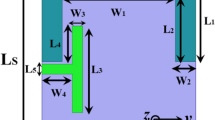Abstract
The design of microstrip antennas for a 6G application is the main emphasis of this work. In the area of mobile communication, the rate of scientific and technological advancement has never slowed. To handle the enormous quantity of data traffic brought on by the increase in wirelessly linked devices, 6G was created. In addition, it provides customers with massive capacity, low latency, high bit rates, a variety of brand-new services, and vertical applications. Due to this, the new THz band frequency range is in focus. This study focuses on designing an antenna that operates at 250 GHz, where ground plane and patch antenna is used which is made of copper material and substrate is made of polyimide film which has ε = 3.4 where the antenna's performance was examined and improvements were made. The simulation results show that the proposed single-element 6G antenna has a greater gain of 6.41 dBi and a larger bandwidth of 8.25 GHz between 246.50 GHz and 254.75 GHz at − 10 dB level.









Similar content being viewed by others
Data availability
All the data for designing antenna which is created or used during the study are openly available.
References
Jha KR, Singh G. Terahertz planar antennas for next generation communication. Cham: Springer International Publishing; 2014. https://doi.org/10.1007/978-3-319-02341-0.
Tekbiyik K, Ekti AR, Kurt GK, Gorcin A. Terahertz band communication systems: challenges, novelties and standardization efforts. Phys Commun. 2019;35(100700):1–18. https://doi.org/10.1016/j.phycom.2019.04.014.
Rouse M. 6G,TechTarget, 2020. https://searchnetworking.techtarget.com/definition/6G.
Saad W, Bennis M, Chen M. A vision of 6G wireless systems: applications, trends, technologies, and open research problems. IEEE Netw. 2020;34(3):134–42. https://doi.org/10.1109/MNET.001.1900287.
Aqlan B, Himdi M, Le Coq L, Vettikalladi H. Sub-THz circularly polarized horn antenna using wire electrical discharge machining for 6G wireless communications. IEEE Access. 2020;8:117245–52. https://doi.org/10.1109/ACCESS.2020.3003853.
Kokkonen M, Myllymaki S, Jantunen H. 3×3 dipole lens antenna at 300 GHz with different permittivity lenses. In: 2nd 6G wireless summit 2020: gain edge for the 6G era, 6G, SUMMIT 2020, pp. 4–7 (2020). https://doi.org/10.1109/6GSUMMIT49458.2020.9083825.
Chi L, Weng Z, Qi Y, Drewniak JL. A 60 GHz PCB wideband antenna-in-package for 5G/6G applications. IEEE Antennas Wirel Propag Lett. 2020;12(25):1. https://doi.org/10.1109/LAWP.2020.3006873.
Ansha KK, Abdulla P, Sam Kollannore U. Design of broadband circularly polarized THz antenna with stable radiation pattern for 6g communications. Optik. 2021;24(3):167397. https://doi.org/10.1016/j.ijleo.2021.167397.
Sa’don SNH, Kamarudin MR, Dahri MH, Ashyap AYI et al. The review and analysis of antenna for sixth generation (6G) applications. In: IEEE International RF and microwave conference (RFM), 2020.
Nissanov U, Singh G, Kumar P, Kumar N. High gain terahertz microstrip array antenna for future generation cellular communication. In: 2020 International conference on artificial intelligence, big data, computing and data communication systems (icABCD), 2020, pp. 1–6. https://doi.org/10.1109/icABCD49160.2020.9183864.
Nissanov U, Singh G, Segun A. Sixth-generation (6G) microstrip antenna with high-gain. Int J Commun Antenna Propag (IRECAP). 2021;11(4):279–87. https://doi.org/10.15866/irecap.v11i4.20665.
Acknowledgements
We thank management and staff of GSSSIETW, for providing the Timely support for completing the work.
Funding
This research was funded by “Consolidated University Research for Innovation and Excellence CORE Grant for Women PG College” (DST-CURIE), Department of Science and Technology, Govt. of India, New Delhi, India, “DST/CURIE-PG/2022/71”.
Author information
Authors and Affiliations
Contributions
Visualization, JJ and M; conceptualization, JJ and M; methodology, JJ and MB; resources, RHK and GKS; writing—original draught, RS and MB; writing—review and editing, JJ. All authors have contributed to other cases. The manuscript's published form was approved by all authors after they had read it.
Corresponding author
Ethics declarations
Conflict of Interest
The authors declare no competing interests.
Additional information
Publisher's Note
Springer Nature remains neutral with regard to jurisdictional claims in published maps and institutional affiliations.
This article is part of the topical collection “Advances in Computational Intelligence, Paradigms and Applications” guest edited by Young Lee and S. Meenakshi Sundaram.
Rights and permissions
Springer Nature or its licensor (e.g. a society or other partner) holds exclusive rights to this article under a publishing agreement with the author(s) or other rightsholder(s); author self-archiving of the accepted manuscript version of this article is solely governed by the terms of such publishing agreement and applicable law.
About this article
Cite this article
Jayanth, J., Mahadevaswamy, M., Shreehansa, R. et al. Design and Analysis of Sixth-Generation (6G) Microstrip Patch Antenna. SN COMPUT. SCI. 4, 153 (2023). https://doi.org/10.1007/s42979-022-01506-1
Received:
Accepted:
Published:
DOI: https://doi.org/10.1007/s42979-022-01506-1




